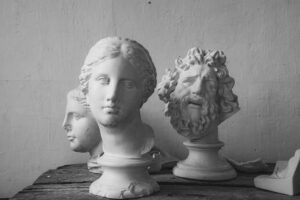Sculpture is one of the most fascinating art forms in the world, and for good reason. It allows artists to create three-dimensional forms that can be appreciated from all angles. Whether you’re a seasoned sculptor or just starting out, mastering this art form takes time, patience, and practice. In this blog post, we’ll explore everything you need to know about the art of sculpture and how to create stunning three-dimensional works of art that will leave your audience awe-inspired. So grab your tools and let’s get started!
What is Sculpture?
Sculpture is an art form that involves creating three-dimensional forms by carving, modeling, or casting materials such as stone, metal, clay or wood.
Unlike painting and drawing which are two-dimensional art forms, sculpture allows artists to create works of art that can be experienced from all angles.
Sculpture has been a significant part of human culture for thousands of years.
The earliest known sculptures date back to the prehistoric era when humans created figurines out of bone and ivory.
Throughout history, sculpture has been used for many purposes including religious expression, commemoration of important individuals or events and decoration.
There are many different types of sculpture including relief sculptures which sit on a flat surface but have depth in their design.
We also have freestanding sculptures which stand independently; kinetic sculptures which move with the wind or touch.
Likewise installation pieces which transform entire spaces and performance art pieces where artists incorporate their bodies into sculptural works.
One unique aspect about sculpture is its ability to interact with space – not only does it occupy physical space but it also defines it by playing with light and shadow.
This means that viewers can experience sculptures in various ways depending on lighting conditions and the angle at which they view them.
Sculpting is a challenging yet rewarding process that requires patience, skill and creativity. It’s no wonder why people continue to explore this fascinating art form today!
Different Types of Sculpture
Sculpture is an art form that has been present for centuries, and throughout this time, various styles have emerged. Some of the different types of sculpture include:
1. Classical Sculpture
Classical sculptures are known for their realism and perfect proportions. They were created in ancient Greece and Rome during the 5th century BC to the 5th century AD.
2. Abstract Sculpture
Abstract sculptures do not depict any recognizable object or figure but instead focus on shapes, lines, colors, and textures to create a unique visual language.
3. Figurative Sculpture
Figurative sculptures represent human or animal figures in realistic or stylized forms.
4. Environmental Sculptures
Environmental sculptures are large-scale artworks that interact with the environment around them – whether natural or man-made.
5. Installation Sculptures
Installation sculptures involve creating three-dimensional works that transform a space – indoors or outdoors – into an immersive experience for viewers.
6. Relief Sculptures
Relief sculptures are those where a figure or design projects from but remains attached to a flat background surface such as walls, ceilings, doors, etc.
Each type of sculpture requires its own techniques and materials to bring it to life effectively!
The Sculpting Process
Sculpting is a medium that has been used throughout history to create three-dimensional forms of art.
The sculpting process involves taking a block of material and carving it into the desired shape, often using specialized tools.
The first step in the sculpting process is to choose the right material for your sculpture, such as stone or clay.
Stone sculptures require more strength and precision than clay sculptures, which are more forgiving.
Once you have chosen your material, you will need to create a rough outline of your sculpture using sketches or drawings.
This will help guide you as you begin carving.
Next comes the actual sculpting process – this can take weeks or even months depending on the complexity of the piece.
It’s important to have patience and dedication during this stage.
As you progress with your sculpture, it’s essential to pay attention to details: proportions, textures, lines…
All these elements contribute towards creating an overall sense of balance and harmony within the finished artwork.
Once all details have been perfected and refined over time through repetitions , finishings touches can be applied- polishing stones surfaces; glazing ceramic pieces…
These final steps give life and character onto each piece thus making them stand out as unique works in their own way!
Famous Sculptors and Their Work
Famous Sculptors and Their Work
Sculpture has been around for centuries, and throughout history, there have been many great artists who specialized in this art form.
Some of the most famous sculptors include Michelangelo, Auguste Rodin, Donatello, and Gian Lorenzo Bernini.
Michelangelo is perhaps best known for his statue of David which was completed in 1504.
This masterpiece stands at over 17 feet tall and is carved entirely out of a single block of marble.
The detail that Michelangelo put into every aspect of the sculpture is truly remarkable.
Auguste Rodin’s most famous work, The Thinker (Le Penseur), has become an iconic image representing philosophical thought.
It depicts a man deep in thought as he sits on a rock with his chin resting on his hand.
Donatello was one of the greatest Italian Renaissance sculptors who created some of the world’s most beautiful sculptures such as David.
His works were characterized by their naturalism and emotional expression.
Gian Lorenzo Bernini was an Italian architect, painter sculptor from the Baroque period whose works included fountains (like Fontana dei Quattro Fiumi) sculptures like Ecstasy Of St Teresa among others .
Each artist had their own unique style, but they all shared a passion for creating three-dimensional forms that would stand the test of time.
These masterpieces still inspire awe today – proof that sculpture truly is an art form to be admired and celebrated forevermore!
Conclusion
The art of sculpture is a fascinating and intricate process that requires both technical skill and artistic vision.
Creating three-dimensional forms allows us to explore the world around us.
It helps in a completely unique way, bringing objects and ideas to life in tangible form.
Whether you’re just starting out or have been sculpting for years, you’ve new things to learn about this dynamic art form.
By exploring different techniques, materials, and styles of sculpture, you can continue to grow as an artist and push your creative boundaries.
So if you’re interested in learning more about how to create three-dimensional forms through the art of sculpture, keep experimenting with different methods until you find what works best for you.
With patience and practice, who knows where your sculpting journey might take you!








